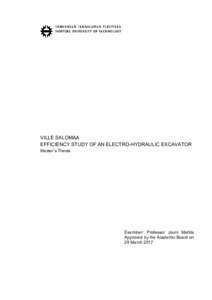Efficiency Study of an Electro-Hydraulic Excavator
Salomaa, Ville (2017)
Salomaa, Ville
2017
Konetekniikka
Teknisten tieteiden tiedekunta - Faculty of Engineering Sciences
This publication is copyrighted. You may download, display and print it for Your own personal use. Commercial use is prohibited.
Hyväksymispäivämäärä
2017-10-04
Julkaisun pysyvä osoite on
https://urn.fi/URN:NBN:fi:tty-201709201904
https://urn.fi/URN:NBN:fi:tty-201709201904
Tiivistelmä
Increasing regulation on emissions and a general trend towards more environmentally friendly solutions has motivated the researchers to look for ways to make mobile machinery more efficient. Excavators particularly are a remarkable source of pollution due to the vast amount and the low efficiency of these machines.
Excavators are ordinarily equipped with conventional, centralized hydraulic system, where main pump supplies volumetric flow for the whole system. This flow is directed from the pump to actuators through control valves, and the returning flow is directed into the tank. Conventional hydraulic system has numerous disadvantages. Many supportive functions are required, including pressure control and load-sensing functions. Even on idle mode, there are flow losses due to continuous circulation of fluid through valves. In addition, the distance between pumps and actuators may be long, which causes pressure loss and an additional weight of long hoses filled with fluid. One proposed improvement is the use of displacement-controlled hydraulics, in which the actuator control is realized by sophisticated pump control, instead of metering the flow in directional valves.
In this work, the efficiency of a modified JCB micro excavator is studied. Excavator is fitted with pressure and position sensors, and the simulation model is verified with laboratory measurements. The literature on the topic is reviewed to find the best practises concerning the studies on mobile machinery efficiency, including standardized duty cycles. The hydraulic system of the excavator is modelled in Matlab Simulink, and the simulation model is utilized to calculate the power consumption of the excavator during a digging and loading and a levelling cycle.
Further simulation study is produced by replacing the conventional hydraulic system with displacement-controlled units, namely direct-driven hydraulics, or DDH’s. The same duty cycles are performed with both systems, and the results are presented. The study shows a power loss of as much as 60% in the directional valve group. A total power consumption of the DDH system is less than 10% of the consumption of conventional system, during two different free-space duty cycles. Subsequently, results of this study will motivate for further research and manufacturing a working prototype.
Excavators are ordinarily equipped with conventional, centralized hydraulic system, where main pump supplies volumetric flow for the whole system. This flow is directed from the pump to actuators through control valves, and the returning flow is directed into the tank. Conventional hydraulic system has numerous disadvantages. Many supportive functions are required, including pressure control and load-sensing functions. Even on idle mode, there are flow losses due to continuous circulation of fluid through valves. In addition, the distance between pumps and actuators may be long, which causes pressure loss and an additional weight of long hoses filled with fluid. One proposed improvement is the use of displacement-controlled hydraulics, in which the actuator control is realized by sophisticated pump control, instead of metering the flow in directional valves.
In this work, the efficiency of a modified JCB micro excavator is studied. Excavator is fitted with pressure and position sensors, and the simulation model is verified with laboratory measurements. The literature on the topic is reviewed to find the best practises concerning the studies on mobile machinery efficiency, including standardized duty cycles. The hydraulic system of the excavator is modelled in Matlab Simulink, and the simulation model is utilized to calculate the power consumption of the excavator during a digging and loading and a levelling cycle.
Further simulation study is produced by replacing the conventional hydraulic system with displacement-controlled units, namely direct-driven hydraulics, or DDH’s. The same duty cycles are performed with both systems, and the results are presented. The study shows a power loss of as much as 60% in the directional valve group. A total power consumption of the DDH system is less than 10% of the consumption of conventional system, during two different free-space duty cycles. Subsequently, results of this study will motivate for further research and manufacturing a working prototype.
